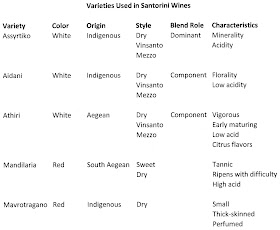Santorini is a 73-square-kilometer archipelago of islands which are the remnants of an ancient volcanic eruption that blew apart their common progenitor, leaving the behind the imposing caldera (Thira) and a number of smaller islands. The islands, the southernmost landmass in the Cyclades chain, lies 113 km to the north of Crete, the largest and most populous of the Greek isles and itself famed for its ancient Minoan society.
 |
| Greek Wine Regions. Source: winesworld.net |
Santorini is one of the European Union's protected designation of origin (PDO; a geographic area used to define a specific quality wine; a European-wide designation that replaced national AOC-type designations in the most recent revision of the European Wine Law) regions with PDOs for dry and sweet white wines. The Santorini viticultural region is 1400 ha in size and runs from sea level up to elevations ranging between 150 and 250 meters.
Santorini has a temperate Mediterranean climate with warm, dry summers and mild winters. Rain is in short supply except for a few short, sharp downpours during the winter months. During the summer months, humidity falls to the ground in a rain-like fashion, a phenomenon that the locals call "pous" which loosely translates to "mist from the sea." During the summer months a hot wind -- Livas -- dominates while north and northwest winds are the order of the day during fall and winter.
Santorini's soil is a testament to its violent past. It is a combination of chalk and shale beneath volcanic deposits of ash, lava, and pumice littered with magnesium and ferrous rocks of varying size. These rocks enrich the phylloxera-free soil with calcium, magnesium, and ferrous iron, the source of the minerality for which the region's wines are known.
In addition to the lack of moisture, another significant challenge to Santorini viticulturists is the stiff wind that buffets the island during the growing season and could damage the berries if they were exposed to the elements. The solution that has been employed for eons is to (i) eschew vine density and (ii) train the vines such that they can afford protection to the otherwise vulnerable berries. Vine canes are intertwined and trained into a circle and the berries grow within this protective cordon. The circular structure can be positioned above ground or in a below-ground hollow where the top of the vine is parallel to the surface.
 |
| Source: Winesfromsantorini.com |
Santorini vines are, for the most part, in excess of 50 years old. Vines are retained until the yield is almost zero or when the vine dies. When the vine is no longer productive, it is replaced by a branch from a nearby vine which is buried to a depth of 30 cm into the soil. After that branch has developed its own roots and has begun producing berries (a period of between 3-5 years) it is cut away from the tethering parent.
The table below shows the varieties that are currently used in Santorini wines. Assyrtiko plantings account for 90% of the region's white wine varieties while Mandilaria accounts for 70% of the red varieties.
There are three PDO appellations in Santorini today: Santorini, Vinsanto, and Nykteri. Santorini is a dry white wine blended from Assyrtiko (minimum 75%) with Aidani and Atheri added to round out Assyrtiko's lack of fruit and aroma. This wine is bone dry with citrus and mineral notes. Vinsanto is sweet white made from Assyrtiko (minimum 50%), Aidani, and other indigenous varieties. The grapes are sun-dried for between one and two weeks after harvesting before they are subjected to a long. slow fermentation followed by several years of bottle aging. Nykteri is a dry white wine made from Assyrtiko (75%) Aidani, and Atheri. The wine gets its name from the tradition of the grapes being picked at night in order to retain the delicate aromas. Today the grapes are picked early in the morning and are preseed and fermented before nightfall. The fermented wine must spend a minimum of three months in barrel. The final product has a semi-yellow color and notes of jasmine, citrus, pear, and vanilla.
A number of non-appellation wines are produced in Santorini:
- Mezzo -- a Vinsanto variant with lower sugar levels
- A dry red made from the Mandilaria grape
- Brouska -- the grapes are aged for a number of days before being pressed and fermented on the skins. This wine is barrel-aged.
© Wine -- The View From Orlando


We really enjoyed our visit to Santorini in October. The Assyrtiko is an impressive wine. The vines roots go down 75 feet because of the dry climate. Interesting that it is pre-phyloxera root stock.
ReplyDeleteAssyrtiko, in my view, is one of the world's leading whites; and eventually the world will catch up with that reaiity. Thanks for your comment.
DeleteI loved Santorini. Such a beautiful place! While there we toured a winery that included an interactive underground museum detailing the history of wine on the island. I was very disappointed that due to some silly law we were not allowed to bring Greek wines back to the US. I did bring back some Vinsanto chocolate!!
ReplyDeleteHate those silly laws. But, like you said, you got some chocolate out of the deal. Thanks for your comment.
Delete